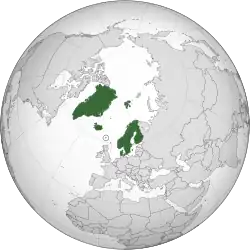
Larger flags, from left to right: Iceland, Faroe Islands, Denmark, Norway, Sweden, Finland;
Smaller flags, from left to right: Barra, South Uist, Yorkshire West Riding (historical), Orkney, Shetland, Scania, Åland, Pärnu, Setomaa (ethnic), Vepsians (ethnic).
A Nordic cross flag is a flag bearing the design of the Nordic or Scandinavian cross, a cross symbol in a rectangular field, with the centre of the cross shifted towards the hoist.
All independent Nordic countries have adopted such flags in the modern period, and while the Nordic cross is named for its use in the national flags of the Nordic nations, the term is used universally by vexillologists, in reference not only to the flags of the Nordic countries but to other flags with similar designs.[1] The sideways cross is also known as the Cross of Saint Philip the Apostle, who preached not in Scandinavia but in Greece, Phrygia and Syria instead.
The cross design represents Christianity,[2][3][4] and was first seen in the Dannebrog, the national flag of Denmark in the first half of the 13th century. The same design, but with a red Nordic cross on a yellow background, was used as union flag during the Kalmar union (1397 to 1523), and when that union fell apart in 1523 the same design, but with a yellow cross on a blue background (derived from the Swedish coat of arms adopted in 1442), was adopted as national flag of Sweden, while Norway adopted their flag in 1821. From its adoption in the early 16th century until 1906 the background of the flag of Sweden was dark blue, but was changed to the currently used lighter shade of blue in a new flag law that was adopted in 1906, after the dissolution of the union between Sweden and Norway. After gaining independence the other Nordic countries adopted national flags of the same design, Iceland in 1915 and Finland in 1917. The Norwegian flag was the first Nordic cross flag with three colours. All Nordic flags may be flown as gonfalons as well.
Flag formats
 Bicolor Nordic/Scandinavian cross
Bicolor Nordic/Scandinavian cross Tricolor Nordic/Scandinavian cross
Tricolor Nordic/Scandinavian cross Bicolor Swallowtail Nordic/Scandinavian cross
Bicolor Swallowtail Nordic/Scandinavian cross Tricolor Swallowtail Nordic/Scandinavian cross
Tricolor Swallowtail Nordic/Scandinavian cross
Flags of the Nordic countries
Some of these flags are historical. Also, flag proportions may vary between the different flags and sometimes even between different versions of the same flag.
The Flag of Greenland is the only national flag of a Nordic country or territory without a Nordic Cross. When Greenland was granted home rule, the present flag — with a graphic design unique to Greenland — was adopted in June 1985, supported by fourteen votes against eleven who supported a proposed green-and-white Nordic cross.[5]
Denmark
 Flag of Denmark (1748)
Flag of Denmark (1748).svg.png.webp) State flag of Denmark (17th century)
State flag of Denmark (17th century) Naval ensign of Denmark (17th century). Note the darker kraprød colour (1939).
Naval ensign of Denmark (17th century). Note the darker kraprød colour (1939). Royal standard of Denmark
Royal standard of Denmark Standard of Frederik the Crown Prince of Denmark
Standard of Frederik the Crown Prince of Denmark Standard of the Regent of Denmark
Standard of the Regent of Denmark Standard of the royal house- used by other members of the royal family
Standard of the royal house- used by other members of the royal family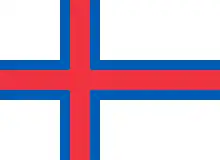 Flag of the Faroe Islands (1919)
Flag of the Faroe Islands (1919)
Finland
 Flag of Finland (1918)
Flag of Finland (1918).svg.png.webp) State flag of Finland (1918)
State flag of Finland (1918)
 Flag of the president of Finland, with the Cross of Liberty in the canton (1978)
Flag of the president of Finland, with the Cross of Liberty in the canton (1978) Finnish yacht club ensign. Ratified club emblem in the canton (1919)
Finnish yacht club ensign. Ratified club emblem in the canton (1919) Flag of Åland (1954)
Flag of Åland (1954)
Iceland
 Flag of Iceland (1944–present)
Flag of Iceland (1944–present).svg.png.webp) State flag of Iceland
State flag of Iceland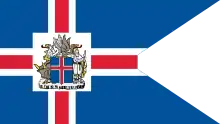 Flag of the president of Iceland
Flag of the president of Iceland Flag of the Icelandic Directorate of Customs
Flag of the Icelandic Directorate of Customs
Norway
 Flag of Norway (1821–1844 and 1899–present)
Flag of Norway (1821–1844 and 1899–present) Naval ensign of Norway since 1905, civilian state flag since 1899.
Naval ensign of Norway since 1905, civilian state flag since 1899..svg.png.webp) Former flag of Norway (1814–1821).
Former flag of Norway (1814–1821)..svg.png.webp) The common naval ensign and war flag of Sweden and Norway from 1815 to 1844.
The common naval ensign and war flag of Sweden and Norway from 1815 to 1844.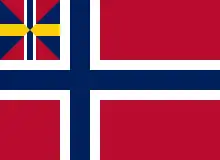 Merchant flag of Norway (1844–1898 with the union badge representing the union with Sweden)
Merchant flag of Norway (1844–1898 with the union badge representing the union with Sweden).svg.png.webp) Naval ensign and state flag of Norway (1844–1905)
Naval ensign and state flag of Norway (1844–1905)
Sweden
 Flag of Sweden (1906–present)
Flag of Sweden (1906–present) Flag of Sweden before 1815
Flag of Sweden before 1815 Flag of Sweden (1815–1844) representing the union with Norway
Flag of Sweden (1815–1844) representing the union with Norway.svg.png.webp) Flag of Sweden (1844–1905) representing the union with Norway
Flag of Sweden (1844–1905) representing the union with Norway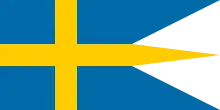 Naval ensign of Sweden
Naval ensign of Sweden Royal standard of Sweden with the Greater coat of arms, used by the King and Queen of Sweden
Royal standard of Sweden with the Greater coat of arms, used by the King and Queen of Sweden Royal standard of Sweden with the lesser coat of arms, used by princes and princesses of Sweden
Royal standard of Sweden with the lesser coat of arms, used by princes and princesses of Sweden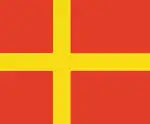
Kalmar Union
This is the historical flag of the Kalmar Union, which united Denmark, Sweden and Norway from 1397 to 1523. No pictorial evidence survives of the Kalmar Union's Flag. The flag appearing here is a reconstruction based on references in 1430 letters by King Eric of Pomerania.
Unofficial Nordic flags
These flags either do not have official status or represent various private entities. They have not been officially adopted and their use remains limited.
 Proposed flag of Norway by Christian Frederick (1814)
Proposed flag of Norway by Christian Frederick (1814) Proposed flag of Norway (Anonymous proposal) (1814)
Proposed flag of Norway (Anonymous proposal) (1814) Proposed flag of Norway by Niels Aall (1815)
Proposed flag of Norway by Niels Aall (1815)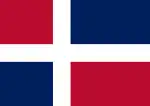 Proposed flag of Norway by Fredrik Meltzer (1821)
Proposed flag of Norway by Fredrik Meltzer (1821)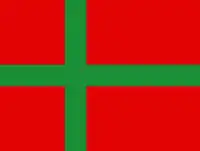 Unofficial flag of Bornholm (1970s)
Unofficial flag of Bornholm (1970s)
 Another proposal for flag of Jutland, dating from 1972 (not in use)
Another proposal for flag of Jutland, dating from 1972 (not in use) Proposal for a flag of Greenland, designed in 1984 by Sven Tito Achen. Rejected in favour of the non-Nordic-Cross flag.
Proposal for a flag of Greenland, designed in 1984 by Sven Tito Achen. Rejected in favour of the non-Nordic-Cross flag.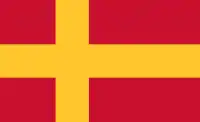 Unofficial flag representing the Swedish-speaking minority in Finland. To be flown along with the Finnish National Flag (1902)
Unofficial flag representing the Swedish-speaking minority in Finland. To be flown along with the Finnish National Flag (1902)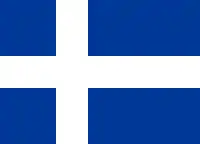
 Former unofficial flag of Iceland (ca. 1900)
Former unofficial flag of Iceland (ca. 1900) Proposal for flag of Iceland, designed in 1914 by Magnús Þórðarson
Proposal for flag of Iceland, designed in 1914 by Magnús Þórðarson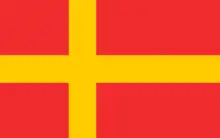 Flag of Norwegian fascist party Nasjonal Samling (1933–1945)
Flag of Norwegian fascist party Nasjonal Samling (1933–1945) Unofficial flag of the Finnish speaking minority in Sweden
Unofficial flag of the Finnish speaking minority in Sweden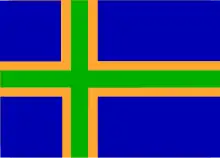 Flag of Vendsyssel, Denmark
Flag of Vendsyssel, Denmark Unofficial flag of Norrland, the northernmost land of Sweden
Unofficial flag of Norrland, the northernmost land of Sweden Flag of the Swedish region of Bergslagen
Flag of the Swedish region of Bergslagen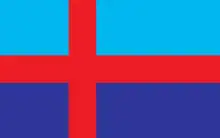 Flag of the Swedish province of Bohuslän
Flag of the Swedish province of Bohuslän Flag of Gotland, the unofficial flag of the Swedish island (and province) of Gotland
Flag of Gotland, the unofficial flag of the Swedish island (and province) of Gotland Flag of the Swedish province of Hälsingland
Flag of the Swedish province of Hälsingland Unofficial flag of the Swedish province of Härjedalen
Unofficial flag of the Swedish province of Härjedalen Flag of the Swedish province of Småland
Flag of the Swedish province of Småland Flag of the Swedish county of Västra Götaland (or West Sweden in general)
Flag of the Swedish county of Västra Götaland (or West Sweden in general) Flag of the Swedish province of Öland
Flag of the Swedish province of Öland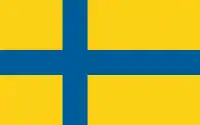 Unofficial flag of the Swedish province of Östergötland
Unofficial flag of the Swedish province of Östergötland
Nordic cross flags outside the Nordic countries
Armenia
 Flag of Ejmiatsin.
Flag of Ejmiatsin.
Brazil
 Flag of Areias, São Paulo State
Flag of Areias, São Paulo State Flag of Borborema, São Paulo State
Flag of Borborema, São Paulo State Flag of Carmo do Paranaíba, Minas Gerais
Flag of Carmo do Paranaíba, Minas Gerais Flag of Chapadinha, Maranhão
Flag of Chapadinha, Maranhão Flag of Colorado, Rio Grande do Sul
Flag of Colorado, Rio Grande do Sul Flag of Domingos Martins, Espírito Santo
Flag of Domingos Martins, Espírito Santo Flag of Escada, Pernambuco
Flag of Escada, Pernambuco Flag of Frei Martinho, Paraíba
Flag of Frei Martinho, Paraíba Flag of Grão Pará, Santa Catarina
Flag of Grão Pará, Santa Catarina Flag of Guaíra, São Paulo State
Flag of Guaíra, São Paulo State Flag of Itu, São Paulo State
Flag of Itu, São Paulo State Flag of Lagoa Formosa, Minas Gerais
Flag of Lagoa Formosa, Minas Gerais Flag of Nova Prata, Rio Grande do Sul
Flag of Nova Prata, Rio Grande do Sul Flag of Palotina, Paraná
Flag of Palotina, Paraná Flag of Peritiba, Santa Catarina
Flag of Peritiba, Santa Catarina Flag of Pirapora do Bom Jesus, São Paulo State
Flag of Pirapora do Bom Jesus, São Paulo State Flag of Santa Helena, Paraná
Flag of Santa Helena, Paraná Flag of Santo Antônio do Pinhal, São Paulo State
Flag of Santo Antônio do Pinhal, São Paulo State Flag of Santo Cristo, Rio Grande do Sul
Flag of Santo Cristo, Rio Grande do Sul
Estonia
 Flag of Pärnu
Flag of Pärnu Flag of Türi Parish
Flag of Türi Parish Flag of Koigi Parish
Flag of Koigi Parish Flag of Setomaa
Flag of Setomaa Proposed flag for Estonia
Proposed flag for Estonia Proposed flag for Estonia (2)
Proposed flag for Estonia (2) Proposed flag for Estonia (3)
Proposed flag for Estonia (3) Proposed flag for Estonia (1919)
Proposed flag for Estonia (1919)
France
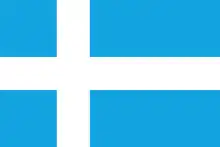 Flag of Calais, Hauts-de-France
Flag of Calais, Hauts-de-France Flag of Dol-de-Bretagne, Brittany
Flag of Dol-de-Bretagne, Brittany Alternative flag of Normandy, nicknamed "St. Olaf's Cross"
Alternative flag of Normandy, nicknamed "St. Olaf's Cross" Alternative flag of Normandy
Alternative flag of Normandy Flag of Presqu'île de Crozon, Brittany
Flag of Presqu'île de Crozon, Brittany Viking flag of Vendée, Pays de la Loire
Viking flag of Vendée, Pays de la Loire
Georgia

 Flag of the Georgian Orthodox Church
Flag of the Georgian Orthodox Church Flag of Gori Municipality
Flag of Gori Municipality Flag of Khoni Municipality
Flag of Khoni Municipality Current flag of Zugdidi Municipality
Current flag of Zugdidi Municipality Old flag of Zugdidi Municipality (2012–2018)
Old flag of Zugdidi Municipality (2012–2018) Variation of the old flag of Zugdidi Municipality (2015)
Variation of the old flag of Zugdidi Municipality (2015)
Germany
Nordic flag designs very similar to Denmark's, Sweden's, and Norway's national flags were proposed as Germany's national flags in both 1919 and 1948, after World War I and World War II, respectively. Today, the Nordic cross is a feature in some city and district flags or coats of arms.
 The unofficial 'Noordlandflagg' of Low German-speaking people in northern Germany, northeastern Netherlands and southern Denmark
The unofficial 'Noordlandflagg' of Low German-speaking people in northern Germany, northeastern Netherlands and southern Denmark Teutonic Knights and their State
Teutonic Knights and their State
 Flag of the Danish monarch, flown in his capacity as Duke of Holstein, Schleswig and Lauenburg. The three duchies were ceded to Austria and Prussia in 1864 as a result of the Second Schleswig War.[7]
Flag of the Danish monarch, flown in his capacity as Duke of Holstein, Schleswig and Lauenburg. The three duchies were ceded to Austria and Prussia in 1864 as a result of the Second Schleswig War.[7].svg.png.webp)
.svg.png.webp) Former North German Federal Navy Ensign (1867–71), Reichskriegsflagge
Former North German Federal Navy Ensign (1867–71), Reichskriegsflagge.svg.png.webp) Former War Ensign of Nazi Germany (1938–1945), now illegal in Germany
Former War Ensign of Nazi Germany (1938–1945), now illegal in Germany.svg.png.webp) Flag of the former Saar Protectorate, Germany
Flag of the former Saar Protectorate, Germany Proposed National flag of Germany, circa 1919.
Proposed National flag of Germany, circa 1919. Flag proposed by the conspirators of the 20 July plot against Hitler, nowadays often used in a right-wing context.[9] (Wirmer Flag)
Flag proposed by the conspirators of the 20 July plot against Hitler, nowadays often used in a right-wing context.[9] (Wirmer Flag)
Hungary
 Flag of Balatonszőlős
Flag of Balatonszőlős Flag of Kozármisleny
Flag of Kozármisleny Flag of Tatárszentgyörgy
Flag of Tatárszentgyörgy Flag of Fűzvölgy
Flag of Fűzvölgy.svg.png.webp) Flag of Pat
Flag of Pat
Latvia

 Flag of Cēsis
Flag of Cēsis Flag of Cēsis Municipality, 2022–
Flag of Cēsis Municipality, 2022– Flag of Ventspils
Flag of Ventspils Flag of Ventspils Municipality
Flag of Ventspils Municipality Flag of the former Grobiņa Municipality, 2011–2021
Flag of the former Grobiņa Municipality, 2011–2021 Nordic cross proposal for Latvian flag
Nordic cross proposal for Latvian flag
Lithuania
 Nordic cross proposal for Lithuanian flag
Nordic cross proposal for Lithuanian flag
Netherlands
 Flag of Aldtsjerk
Flag of Aldtsjerk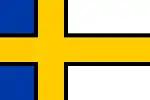 Flag of Bedum
Flag of Bedum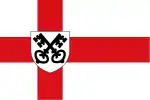 Flag of Havelte
Flag of Havelte Flag of Hof van Twente
Flag of Hof van Twente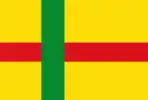 Flag of Koewacht
Flag of Koewacht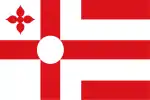 Flag of Rosmalen
Flag of Rosmalen Flag of Skarsterlân
Flag of Skarsterlân Flag of Tilburg
Flag of Tilburg Flag of Utrechtse Heuvelrug
Flag of Utrechtse Heuvelrug Flag of Wierden
Flag of Wierden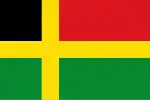 Flag of Wouw
Flag of Wouw
Russia
 Flag of Alyoshino, Tver Oblast
Flag of Alyoshino, Tver Oblast.png.webp) Flag of Levokumsky District
Flag of Levokumsky District.svg.png.webp) Flag of Likhoslavlsky District
Flag of Likhoslavlsky District Flag of Mikhaylovsk, Stavropol Krai
Flag of Mikhaylovsk, Stavropol Krai.png.webp) Flag of Mikhaylovskoe, Republic of Karelia
Flag of Mikhaylovskoe, Republic of Karelia.png.webp) Flag of Plodovskoe, Leningrad Oblast
Flag of Plodovskoe, Leningrad Oblast.png.webp) Flag of Predgorny District, 1997–2017
Flag of Predgorny District, 1997–2017.png.webp) Flag of Rameshki, Tver Oblast
Flag of Rameshki, Tver Oblast.png.webp) Flag of Rameshkovsky District
Flag of Rameshkovsky District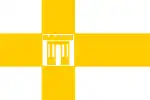 Flag of Stavropol
Flag of Stavropol Flag of Stavropol Krai
Flag of Stavropol Krai
Spain
.svg.png.webp) Flag of Burón
Flag of Burón.svg.png.webp) Flag of Casar de Palomero
Flag of Casar de Palomero.svg.png.webp) Flag of Paterna del Río
Flag of Paterna del Río Alternative flag of Tudela, Navarre
Alternative flag of Tudela, Navarre
Teutonic Order
 Flag of the State of the Teutonic Order (1230–1525)
Flag of the State of the Teutonic Order (1230–1525)
Ukraine
 Flag of Volyn Oblast
Flag of Volyn Oblast Flag of Zhytomyr
Flag of Zhytomyr Flag of Bershad Raion
Flag of Bershad Raion Flag of Khrestivka
Flag of Khrestivka
United Kingdom
A number of flags for localities in the United Kingdom (primarily Scotland) are based on Nordic cross designs, intended to reflect the Scandinavian heritage introduced to the British Isles during the Viking Age and through the High Middle Ages.[10]
 Flag of Shetland (2005)
Flag of Shetland (2005) Flag of Orkney (2007)
Flag of Orkney (2007) Flag of Caithness (2016)
Flag of Caithness (2016) Flag of Yorkshire West Riding (2013)
Flag of Yorkshire West Riding (2013)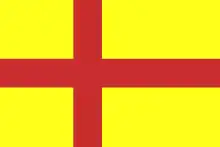 Cross of St Magnus, former unofficial Flag of Orkney (1990s)
Cross of St Magnus, former unofficial Flag of Orkney (1990s)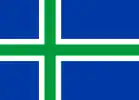 Unofficial flag of North Uist (2018)
Unofficial flag of North Uist (2018) Flag of the island of South Uist (recognised 2017)[11]
Flag of the island of South Uist (recognised 2017)[11] Isle of Barra (recognised 2017)[12]
Isle of Barra (recognised 2017)[12] Flag of the Isle of Skye (2020)
Flag of the Isle of Skye (2020) Official flag of Sutherland (2018)
Official flag of Sutherland (2018).svg.png.webp) Proposed flag of Lancashire (1990s)
Proposed flag of Lancashire (1990s) Proposed flag of Orkney (2007)
Proposed flag of Orkney (2007) Proposed flag of Orkney (2007)
Proposed flag of Orkney (2007)_-_joint_2nd_place%252C_Guscott.svg.png.webp) Proposed flag of Somerset (2013)
Proposed flag of Somerset (2013)
United States
 Flag of Bayamón, Puerto Rico
Flag of Bayamón, Puerto Rico Flag of Little Rock, Arkansas
Flag of Little Rock, Arkansas.png.webp) Flag of Staunton, Virginia
Flag of Staunton, Virginia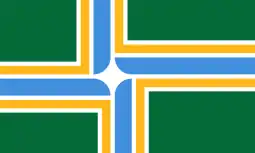
 Campaign Flag of the Puerto Rican Independence Party
Campaign Flag of the Puerto Rican Independence Party Flag of Wilmington, Delaware
Flag of Wilmington, Delaware Flag of the Episcopal Church
Flag of the Episcopal Church Flag of New Milford, Connecticut
Flag of New Milford, Connecticut
Other
 Flag of a Chilean ambassador
Flag of a Chilean ambassador.svg.png.webp)

 Royal Standard of Greece (1863). Note: George I was also a prince of Denmark.
Royal Standard of Greece (1863). Note: George I was also a prince of Denmark.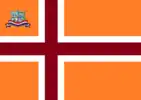 Flag of Hernandarias, Paraguay
Flag of Hernandarias, Paraguay Proposed flag of South Island, New Zealand
Proposed flag of South Island, New Zealand.svg.png.webp) Naval ensign of South Africa (1952–1981)
Naval ensign of South Africa (1952–1981)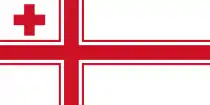

 Flag of Ladonia, a micronation in southern Sweden. The white lines are not visible on the flag itself, yet it is still seen as bearing a Nordic Cross as it represents a boiled Swedish flag.
Flag of Ladonia, a micronation in southern Sweden. The white lines are not visible on the flag itself, yet it is still seen as bearing a Nordic Cross as it represents a boiled Swedish flag. Unofficial flag of the Komi Republic used by activists.
Unofficial flag of the Komi Republic used by activists. Flag of Amambay Department, Paraguay.
Flag of Amambay Department, Paraguay. Flag of the Principality of Snake Hill, a micronation in Australia.
Flag of the Principality of Snake Hill, a micronation in Australia.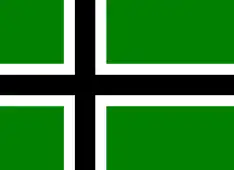 The "Vinland flag", used by American band Type O Negative, now a potential White Supremacist logo.[13]
The "Vinland flag", used by American band Type O Negative, now a potential White Supremacist logo.[13]
 Flag of the Foundation Interdisciplinary Center for Cultural Studies, Argentina
Flag of the Foundation Interdisciplinary Center for Cultural Studies, Argentina
Ethnic flags

 Flag of the Veps since 1992, designed by Vitaly Dobrynin. In 2000–2005 span used as the official flag of Vepsian autonomous region in Russian Karelia
Flag of the Veps since 1992, designed by Vitaly Dobrynin. In 2000–2005 span used as the official flag of Vepsian autonomous region in Russian Karelia One of the two flags of Votians
One of the two flags of Votians Flag of Provisional Government of East Karelia, designed by Akseli Gallen-Kallela in 1920. Later used as the ethnic flag of Karelians
Flag of Provisional Government of East Karelia, designed by Akseli Gallen-Kallela in 1920. Later used as the ethnic flag of Karelians
 Flag of the Sweden Finns
Flag of the Sweden Finns
 Flag of the Mi'kmaq people, Canada (horizontal version)
Flag of the Mi'kmaq people, Canada (horizontal version) Falaise Cross flag (Croix de Falaise) – Falaise in Normandy was the birthplace of William the Conqueror
Falaise Cross flag (Croix de Falaise) – Falaise in Normandy was the birthplace of William the Conqueror Not adopted proposal for the flag of Sápmi
Not adopted proposal for the flag of Sápmi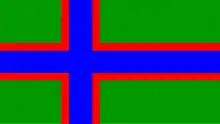 Unofficial flag of Ludic Karelians
Unofficial flag of Ludic Karelians Flag of Setos
Flag of Setos
Sport societies
 Flag of Idrottsföreningen Kamraterna
Flag of Idrottsföreningen Kamraterna Ensign of the Hungarian Yachting Association
Ensign of the Hungarian Yachting Association
Fictional
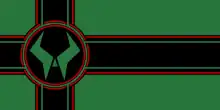 Flag of Latveria, a fictional nation within the Marvel Comics universe
Flag of Latveria, a fictional nation within the Marvel Comics universe Flag of Norsefire, a fictional neofascist party ruling over the United Kingdom in Alan Moore and David Lloyd's comic series V for Vendetta
Flag of Norsefire, a fictional neofascist party ruling over the United Kingdom in Alan Moore and David Lloyd's comic series V for Vendetta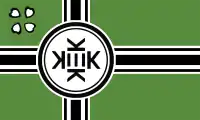 Flag of Kekistan, a fictional country created by 4chan members as a political meme and online movement
Flag of Kekistan, a fictional country created by 4chan members as a political meme and online movement
See also
References
- ↑ EnchantedLearning.com Archived 3 December 2017 at the Wayback Machine; Historical flags of the world: The Scandinavian cross Archived 2 September 2020 at the Wayback Machine; Eric Inglefield: "Fahnen und Flaggen" (translated to German by Dagmar Hahn), Delphin Verlag, Munich 1986, p.16
- ↑ Jeroen Temperman (2010). State Religion Relationships and Human Rights Law: Towards a Right to Religiously Neutral Governance. Martinus Nijhoff Publishers. p. 88. ISBN 978-9004181489. Archived from the original on 23 April 2023. Retrieved 31 December 2007.
Many predominantly Christian states show a cross, symbolising Christianity, on their national flag. The so-called Scandinavian crosses or Nordic crosses on the flags of the Nordic countries–Denmark, Finland, Iceland, Norway and Sweden–also represent Christianity.
- ↑ Carol A. Foley (1996). The Australian Flag: Colonial Relic or Contemporary Icon. William Gaunt & Sons. ISBN 9781862871885. Archived from the original on 23 April 2023. Retrieved 31 December 2007.
The Christian cross, for instance, is one of the oldest and most widely used symbols in the world, and many European countries, such as the United Kingdom, Norway, Sweden, Finland, Denmark, Iceland, Greece and Switzerland, adopted and currently retain the Christian cross on their national flags.
- ↑ Andrew Evans (2008). Iceland. Bradt. ISBN 9781841622156. Archived from the original on 23 April 2023. Retrieved 31 December 2007.
Legend states that a red cloth with the white cross simply fell from the sky in the middle of the 13th-century Battle of Valdemar, after which the Danes were victorious. As a badge of divine right, Denmark flew its cross in the other Scandinavian countries it ruled and as each nation gained independence, they incorporated the Christian symbol.
- ↑ "Nu vajer det grønlandske flag over Danmark". 21 June 2016. Archived from the original on 22 June 2016. Retrieved 24 June 2016.
- ↑ "Kunstavisen på internettet – Artikler". Archived from the original on 2 October 2008.
- ↑ In 1844, pro-German nationalists in the two duchies of Holstein and Schleswig created a blue-white-red tricolour as a symbol for independence which began to see widespread use. In 1845, Denmark responded by outlawing all other flags than the Danish one shown here. This ban was enforced as long as Denmark controlled the three duchies (Holstein and Lauenburg: effectively until 1863, Schleswig effectively until 1864.) Use of the Danish flag was in turn outlawed by the secessionist government that claimed the three duchies between 1848–1851.
- ↑ "Grand Duchy of Oldenburg 1815–1918 (Lower Saxony, Germany)". Flagspot.net. Archived from the original on 25 November 2017. Retrieved 28 December 2017.
- ↑ "Pegida und das Symbol der Hitler-Attentäter". Süddeutsche Zeitung (in German). 3 August 2015. Archived from the original on 20 July 2020. Retrieved 20 July 2020.
- ↑ Scots communities go Nordic in rising demands for their own flags Archived 11 October 2021 at the Wayback Machine HeraldScotland
- ↑ "South Uist flag". Hebrides-news.com. Archived from the original on 29 December 2017. Retrieved 28 December 2017.
- ↑ "Isle of Barra's flag officially recognised". BBC News. 23 November 2017. Archived from the original on 30 December 2017. Retrieved 26 May 2018.
- ↑ "Vinland Flag: General Hate Symbols". Anti-Defamation League. Archived from the original on 24 May 2022. Retrieved 14 October 2022.
- ↑ Пюккенен, А. Ю.; Сыров, А. А. (2002). Что такое Ингерманландия? Краткое введение в историю ингерманландских финнов [What is Ingria? A short introduction to the history of the Ingrian Finns] (in Russian). Saint Petersburg.
{{cite book}}: CS1 maint: location missing publisher (link) - ↑ Пюккенен, А. Ю. (30 May 2011). "Геральдика Невского края" [Neva region heraldry]. Санкт-Петербургские ведомости (in Russian). Saint Petersburg: АО Издательский дом «С.-Петербургские ведомости».
- ↑ "Hur ser Svenskfinland ut om 100 år?" (PDF). Medborgarbladet (in Swedish). Helsinki: Svenska folkpartiet RP. 61 (4): 20. December 2006. Archived from the original (PDF) on 21 July 2011. Retrieved 6 June 2008.
- ↑ Engene, Jan Oskar (10 March 1996). "Swedish speaking population in Finland". Flags of the World. Archived from the original on 7 July 2020. Retrieved 6 June 2008.
- ↑ "Interfrisian flag". Groep fan Auwerk. Archived from the original on 24 September 2015. Retrieved 1 December 2015.
Bibliography
- Znamierowski, Alfred (2002). The world encyclopedia of flags : The definitive guide to international flags, banners, standards and ensigns. London: Hermes House. pp. 103 and 134. ISBN 1-84309-042-2.
External links
![]() Media related to Nordic Cross flags at Wikimedia Commons
Media related to Nordic Cross flags at Wikimedia Commons


